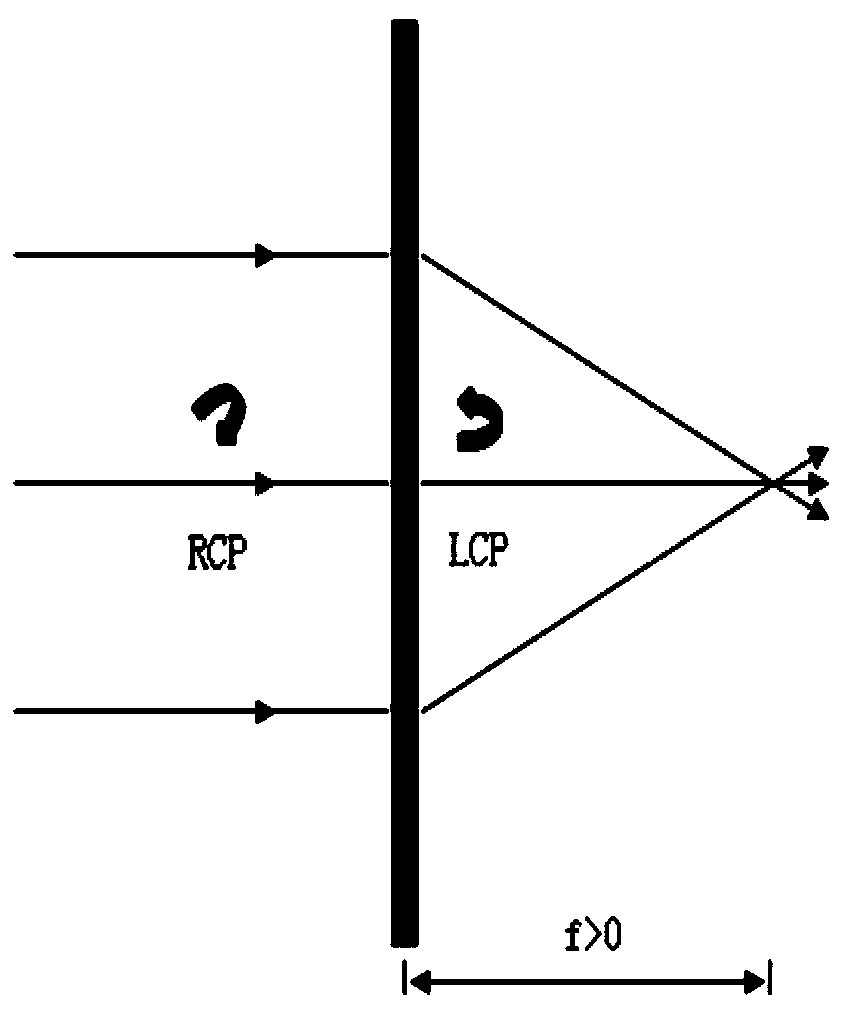Vision correcting device for presbyopia
A vision correction and presbyopia technology, applied in the field of optics, can solve the problems of not ideal optical system, large lens thickness, and inability to see the scene clearly, and achieve the effect of wide vision adjustment range
- Summary
- Abstract
- Description
- Claims
- Application Information
AI Technical Summary
Problems solved by technology
Method used
Image
Examples
Embodiment 1
[0026] This embodiment discloses a vision correction device for presbyopia, comprising: a linear polarizer, a first flat lens based on an electrically controlled birefringence material, and a 1 / 4 wave plate between the linear polarizer and the first flat lens, and Voltage control system for switching flat lens. Optionally, the birefringent material in this embodiment is made of liquid crystal or liquid crystal polymer.
[0027] In this embodiment, the voltage control system is specifically used to control the switch state of the first flat lens, so that: in the case of no electric field when the circuit of the corresponding voltage control system is disconnected, the first flat lens, as figure 1 As shown, achieving a non-zero diffracted beam of the same order is equivalent to converging the beam with a real focal point by a convex lens. On the other hand, if the first flat lens is in the saturated electric field corresponding to the closed circuit of the voltage control syste...
Embodiment 2
[0048] In this embodiment, on the basis of the first embodiment above, the following product improvements are made for users who have presbyopia and myopia at the same time. The specific improvement includes: adding a second flat lens adjacent to the first flat lens in the above device, and the rotation directions of the fast axes of the second flat lens and the first flat lens are opposite to each other under the condition of no electric field.
[0049] In this way, when the first flat lens and the second flat lens are replaced under the condition of no electric field, when the incident light of the same polarization state converges after passing through the first flat lens, the incident light of the polarization state passes through the second flat plate After the lens diverges, or when incident light of the same polarization state diverges after passing through the first flat lens, the incident light of the same polarization state converges after passing through the second f...
Embodiment 3
[0056] Further, on the basis of the first and second embodiments above, this embodiment makes intelligent improvements based on user experience. It specifically includes: setting a working mode sensor in the voltage control system to detect whether the user's head is a bowing action for observing a close-up view, or a head-up or looking-up action based on a distant view; Adaptive electric field state switching. Optionally, the working mode sensor includes but is not limited to a level sensor or other sensors based on visual changes of the user's eyes.
[0057] Optionally, the voltage control system in this embodiment is also provided with a matching switch for the user to enable or disable the adaptive electric field switching based on the working mode sensor. Usually, this switch can not only turn off the automatic switching function to avoid misjudgment, but also allow us to manually switch between the first and second flat lens. In other words, the matching switch can be ...
PUM
 Login to View More
Login to View More Abstract
Description
Claims
Application Information
 Login to View More
Login to View More - R&D
- Intellectual Property
- Life Sciences
- Materials
- Tech Scout
- Unparalleled Data Quality
- Higher Quality Content
- 60% Fewer Hallucinations
Browse by: Latest US Patents, China's latest patents, Technical Efficacy Thesaurus, Application Domain, Technology Topic, Popular Technical Reports.
© 2025 PatSnap. All rights reserved.Legal|Privacy policy|Modern Slavery Act Transparency Statement|Sitemap|About US| Contact US: help@patsnap.com



